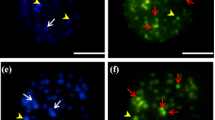Abstract
Two types of extra heterochromatin, in the form of either supernumerary segments or B-chromosomes, have been observed in natural populations of Gomphocerus sibiricus. The presence of a heterochromatic supernumerary segment affecting the M7 pair in a population from the Valle de Arán disturbs the normal separation of this bivalent at anaphase I of meiosis and non-disjunction products, respectively deficient or duplicate for the M7, are present at metaphase II.
A stable Bm chromosome has been detected in a second population from Formigal. In a single individual where a Bm is present together with a small unstable Bs supernumerary chromosome both the Bm and the M5 are unstable in the germ line and in the case of the M5 this unstability leads to a state of germ line polysomy.
Similar content being viewed by others
References
Ehrendorfer, F., 1959. Unterschiedliche Störungssyndrome der Meiose bei diploiden und polyploiden Sippen des Achillea-millefolium-Komplexes und ihre Bedeutung fur die Mikro-Evolution. Chromosoma 10: 482–496.
Gangwere, S. K. & Morales Agacino, E., 1970. The biogeography of iberian orthopteroids. Mis. Zool. Vol. II. 5: 1–67.
Gosálvez, J., López Fernández, C. & Esponda, P., 1980. Variability of the DNA content in five orthopteran species. Caryologia 33: 275–281.
Gosálvez, J., López Fernández, C. & Morales Agacino, E., 1980. Consideraciones cromosómicas sobre algunas especies del grupo Podismini. (Orthoptera: Acrididae). Acrida 9: 133–143.
Hewitt, G. M., 1979. Animal cytogenetics. 3. Insecta. Orthoptera Grasshoppers and Crickets. Borntraeger, Berlin. Stuttgart. 169 pg.
Hewitt, G. M. & John, B., 1968. Parallel polymorphism for supernumerary segments in Chorthippus parallelus (Zettersted). I. British populations. Chromosoma 25: 319–342.
Hewitt, G. M. & John, B., 1970. Parallel polymorphism for supernumerary segments in Chorthippus parallelus (Zettersted). IV. Ashurst re-visited. Chromosoma 31: 198–206.
John, B., 1973. The cytogenetic systems of grasshoppers and locusts. II. The origin and evolution of supernumerary segments. Chromosoma 44: 123–146.
John, B., 1976. Myths and mechanisms of meiosis. Chromosoma 54: 295–325.
John, B. & Freeman, M. 1976. The cytogenetic systems of grasshoppers and locusts. III. The genus Tolgadia (Oxyinae: Acrididae). Chromosoma 55: 105–119.
John, B. & Hewitt, G. M., 1966. A polymorphism for heterochromatic segments in Chorthippus parallelus. Chromosoma 18: 254–271.
John, B. & Hewitt, G. M., 1969. Parallel polymorphism for supernumerary segments in Chrothippus parallelus (Zetterstedt). III. The Ashurst population. Chromosoma 28: 73–84.
John, B. & King, M., 1977. Heterochromatin variation in Cryptobothrus chrysophorus I. Chromosome differentiation in natural populations. Chromosoma 64: 219–239.
John, B. & King, M., 1977b. Heterochromatin variation in Cryptobothrus chrysophorus II. Patterns of C-Banding. Chromosoma: 65: 59–79.
John, B. & King, M., 1980. Heterochromatin variation in Cryptobothrus chrysophorus III. Synthetic hybrids. Chromosoma 78: 165–186.
King, M. & John, B., 1980. Regularities and restrictions governing C-band variation in acridoid grasshoppers. Chromosoma 76: 123–150.
López Fernández, C. & Gosálvez, J., 1981. Differential staining of a heterochromatic zone in Arcyptera fusca. Experientia 37: 240.
Malithano, D. A., 1975. Meiotic behaviour of two supernumerary and structurally changed chromosomes in Tradescantia paludosa. Hereditas 81: 1–18.
Nur, U., 1961. Meiotic behaviour of an unequal bivalent in the grasshopper Calliptamus palaestinensis. Chromosoma 12: 272–279.
Nur, U., 1978. Asymmetrically heteropycnotic X-chromosome in the grasshopper Melanoplus femur-rubrum. Chromosoma 68: 165–185.
Peters, G. B., 1977. Germ line polysomy in Atractomorpha similis. Ph.D. Thesis, Australian National University.
Peters, G. B., 1981. Germ-line polysomy in the grasshopper Atractomorpha similis. Chromosoma 81: 593–617.
Rutishauser, A., 1960. Zur Genetik uberzähliger Chromosomen. Arch. Julius Klaus-Stift. Vererb Forsch. 35: 440–458.
Shaw, D. D., 1970. The supernumerary segment system of Stethophyma. I. Structural basis. Chromosoma 30: 326–343.
Author information
Authors and Affiliations
Rights and permissions
About this article
Cite this article
Gosálvez, J., López-Fernández, C. Extra heterochromatin in natural populations of Gomphocerus sibiricus (Orthoptera: Acrididae). Genetica 56, 197–204 (1981). https://doi.org/10.1007/BF00057560
Received:
Accepted:
Issue Date:
DOI: https://doi.org/10.1007/BF00057560




